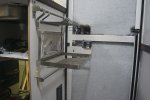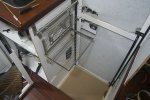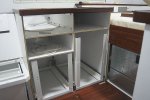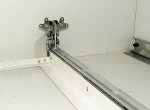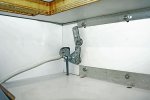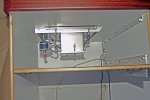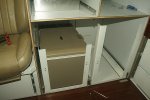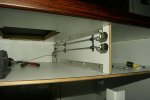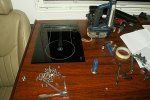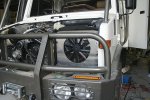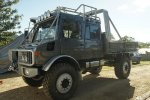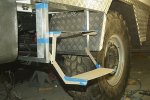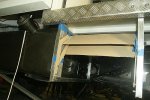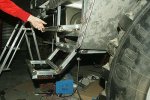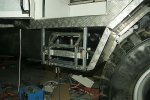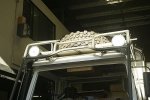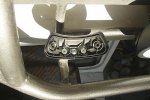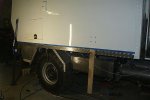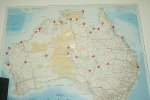Sorry for the lack of updates. I have been working on the truck - not as much as I used to. I've been spending as much time as I can with my wife, all the problems she has been having due to the cancer treatment makes me want to be with her more an more, just to make things easier for her.
She is on the mend, another session of re-constructive surgery tomorrow, and then only one more after that. I'm not sure things will ever get back to the way they were, she will be on the drugs for another 4 years. She sure tries hard to do the things like she used to, but the side effects of the drugs sometimes effect her a lot. Anyway, when it gets to the point that my fussing over her starts to irritate her, she chases me away to work on the truck.
The work over the past two months has all been about plumbing and the electrics. I've installed the hot water heat exchanger, I had to made a frame to get it off the floor, so that all the pipework will fit, otherwise it would be too difficult to get to. Next was to run all the water lines. The system is fairly complex.
The supply system consist of:
Two water tanks
Two independent supply lines
Two pre-filters
Two water pumps
Filler system (common fill point but with each tank isolated)
Air breather system on each tank connected to the fill point, which can also be isolated.
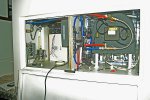
The 20 litre hot water tank is heated by the engine cooling system, and/or the Webasto diesel heater. The on-board cabin heater is also part of the system, with isolation valves on the heaters to block it off when it is not required. As the engine can heat the tank to over 88 degrees, I have to fit a tempering valve - that blends the very hot water from the tank with cold water to reduce the temperature down to 40-50 degrees so it doesn't burn you. Since the water in the tank gets very hot, it expands, so there is also a expansion valve to bleed the excess pressure. The hot water tank can also run off 240V, so it we are hooked up to a powered site for a few days, we can have hot water without having to run the engine or the diesel furnace. Not sure how many times we will actually go to a caravan park, we tend not to like going where there is other people, but the 240V heater was part of the standard package, so I might as well make it work.
The delivery system consists of::
2 shower heads ( hot and cold - one in the entrance way, the other in the boot - which doubles as the outside kitchen tap)
Sink ( hot and cold)
2 drinking water taps (connected to the Seagull IV filter - next to the sink, and another tap in the boot.
Outside hand washing tap ( front passenger side - cold only)
This shows the outside tap, can't see it unless you get under the truck, when the fuel tank is in, it will be hardly noticeable for outside unless you are really short. We can also switch it off from inside the truck. (I just noticed that I need to put the 'P" clips on those wires as well)
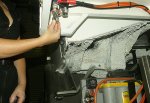
There is a quite a lot of fittings required to get the rigid lines around the compartments, and I have to keep the pipes accessible, but also out of the way. I'm using the John West system of push fit fittings. The fittings can either be a simple push on fitting, but that would be a bit too easy. The best way of doing it is to use inserts on ends of each pipe that reduces the possibilities of leaks, then locking clips to hold the fittings in the full lock position to stop them from coming loose over rough roads. So each pipe has the extra fittings, means you do everything twice, making everything fit, then taking all the pipes off again to fit the inserts, as once they are in, you can't take them out if you need to trim the hose a bit.
This is the outside/inside shower. This hose is long enough to work on the steps, on just outside the door. There will also be another much longer shower hose at the rear. The hose disappears into the hole, and fits inside a PVC tube in the compartment so it is not in the way, or can get tangled.
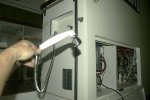
Next in line is the waste water plumbing. The"grey water" from the shower goes into a special "P" trap to prevent it from splashing back up when going off road. The basin has a small 25" outlet, it also have a special "P-trap" but that so that smells don't come back up the pipe. I still have to design the grey water tank, and get it made. It also needs to have a means of heating it - as in winter, I don't want the tank to freeze up so we can't use the shower or basin. I will have a tube running through it, and have the return line from the diesel heating system run inside it.
I've been speaking to Robert van der Hoven, he has travelled extensively around the world in his truck, and is now building a new one. There are a lot of problems that happen with cold weather, the biggest problem being condensation. He said his truck would be soaking wet inside once it gets to 10-20 degrees below freezing. I'm hoping ours won't one of the key things is to get a good air flow going. I have a spare Donaldson sir filter, and will mount that underneath the the truck so that I can suck in air into the water compartment, the filter is just to limit the dust coming in ( and because it have it left over from another project so might as well use it.)
The rear compartment is quite big, so I decided to use some LED strip lights to light it up. The LED are hidden up in the frame work, but cast a really nice light, no shadows either. I fitted them in order to work on the boot area, nice to be able to see what you are doing for a change.
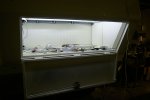
I have finally fitted the bellows as well. This took a long time to get sorted out as there are loads of bolts and screws and since I hurt my shoulder, drilling things vertically upwards is painful. I kept on putting it off, then eventually I felt guilty as my wife had made it, and was always asking how it worked, so I decided to fit it last week. It took a while, but it all in.
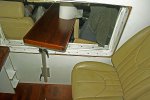
It also works pretty well. I tried to articulate the truck using two high-lift jacks, I got the cab to move about 20cm relative to the camper box, sorry no photos, as when I had it all in position, I discovered the batteries in the camera were flat. The next thing I need Trish to make are the large "pillows" that go between the cab and the camper box. They help with the sealing of the crawl through from heat, noise and water. I won't take this long to fit them once she has made them.
There are loads of other small things I've done that take a long time, one of them is fit the rear clearance lights, I decided to get the big Hella Duraled clearance lights. The wires run down inside the truck, through all the bulkheads and floors, and eventually to the compartment where the tail light wires will be.
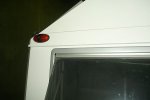
Just to prove I did both sides

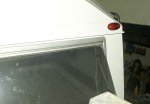
Loads of other small details as well in the inside, like fitting the compression locks for the drawer under the seat.
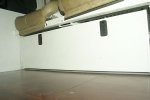
Then fitting the drawer runners for the Stove/Fridge cabinets. I've put the runner on the bottom of the cabinet, so that the load is shared by the base, as well as the screws. Now just need to persuade the cabinet maker to make some drawers ( and finish the rest of the stuff as well)
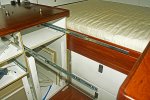
I'll try to keep the updates coming quicker, I hope someone find this useful, and if anyone has any questions or comment, feel free to post them or contact me.

